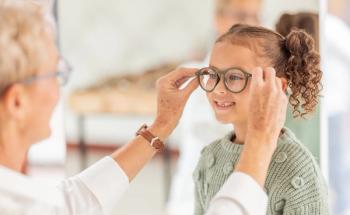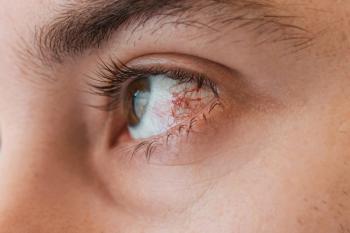
AOA 2024: New wave thinking on wavefront guided contact lenses
The art of scleral lens fitting is coupled with a patient's patience as they neuro-adapt, according to Clark Chang, OD, MSA, MSc, FAAO.
The art of scleral lens fitting is coupled with a patient's patience as they neuro-adapt, according to Clark Chang, OD, MSA, MSc, FAAO. He outlines techniques and tips for fitting scleral lenses to a variety of patients in his AOA Optometry's Meeting talk on wavefront guided contact lenses.
Video transcript
Editor's note: This transcript has been lightly edited for clarity.
Clark Chang, OD, MSA, MSc, FAAO:
Hi everyone, this is Clark Chang. I'm the contact lens director in Cornea Service at Wills Eye as well as the director of medical affairs at Glaukos. Hello again from AOA in Nashville, having great time here, excellent education. I'm very glad to be asked to give a quick recap of my lecture on waveguided optics application in scleral lenses. And so what actually inspired me to give this lecture or put this lecture together, I mean, we've all been waiting for something like this to go beyond the surgical route, right? You may already have patients who have been referred for topo-guided or waveguided or PRK, LASIK, but now we actually can, in the last couple years, have this access to this technology apply, clinically to scleral lenses, now no longer just research based, and soft lenses, and scleral lenses. And we all know that in literature, a lot of irregular cornea patients, especially keratoconus patients, a large percentage of them have residual [high order abberations, or] HOAs that they complain about that. We didn't really know what to do before this Orbis technology, and there's some new technology coming as well. Before we had access to this, we really didn't know what to do I was led to offering them maybe other surgery options, like come back to contact lenses. So that's number one why I thought was very important to share this case-based lecture with the audience both at AOA and with you back at home and hopefully see you in the future.
So let's talk about the waveguided optics. You may have been following the research all along. Like I said, it's much more clinically transferable now. Number one, you need to make sure that your lab cam, whatever instrument you're using, that there's not a specific requirement with your lab manufacturers. Some let manufacturers because their software can only decode specific instrument, and some of them are not, so make sure that you understand from your laboratory point of view what they are using. Like I said, I personally am using the currently the Orbis technology and I want to thank Nick Brown; we put together some article and posters of the cases that I have done clinically so obviously feel free to look that up.
And so let's get on to what do I think is important in your patient selection because I get that asked a lot. I'm already fitting GP, I'm already fitting scleral lenses, I know my patient is not completely happy but they're doing well, so how do I know when to go that next step? I think patients was slightly larger pupil — there's this arvo poster that showed that patient greater than a 5 millimeter pupil can potentially benefit a little bit more than patient with smaller pupil. Caveat for me, I have patients was really abnormally large pupil, say you know 8.5, 9 millimeter, I still feel like I struggle with them. So I think maybe like medium size to large pupil patients because they experience more HOA, they are complaining more about night vision. So of course those are the patient makes sense that they will benefit a little bit more with this technology. Obviously patients who are not happy despite front toric design, and especially if you have some sort of aberrometer that you could do a baseline screening and they have more than .4 micron HOA RMS, a general rule of thumb, they can benefit from this technology.
So one more thing before I go into a quick case for you: you want to make sure you're spending a lot of time giving patients the best of the best. It will take up some of your time, some of patients' time. So make sure that you're not dealing with unstable diseases that can cause the increase in frequency of having to redesign your HOA profile, such as patient was dry eye. I show a video of what the HOA changes as the patients tear film thins out. So dry eye does affect it. Obviously, most common irregular cornea, like keratoconus patients, you want to make sure their cornea is stabilized before you head into this endeavor with them. So that kind of thing.
Just so you know what kind of patients that I've helped with: large pupil, irregular cornea patients, make sure obviously the lens is really centered, you have a larger OZ to cover their pupil so that their vision is good throughout the day, but also at night. I have done corneal scarring patients, PR central, not their central. However, I wouldn't discourage you from trying. Just take a look to see aberrometer can pick up signal in the area of scarring. That often tells you whether or not you can help this patient. I've also had patients who initially pick up the lens, didn't do quite well because they're adapted somewhat to their HOA and so they're not used to getting all the HOA removed, very similar to the rule, if the patient doesn't like it and you change their prescription to against the rule. So also make sure you tell patient that they need to have a little bit of patience. Patience is virtue. Go home, try for a couple of weeks, then come back, and then you'll see what they've neuro-adapted to or not. So I know that's a lot to digest. I'll introduce more cases in a future meeting. I hope I'll see you there. Thanks, everybody.
Newsletter
Want more insights like this? Subscribe to Optometry Times and get clinical pearls and practice tips delivered straight to your inbox.



















































.png)


